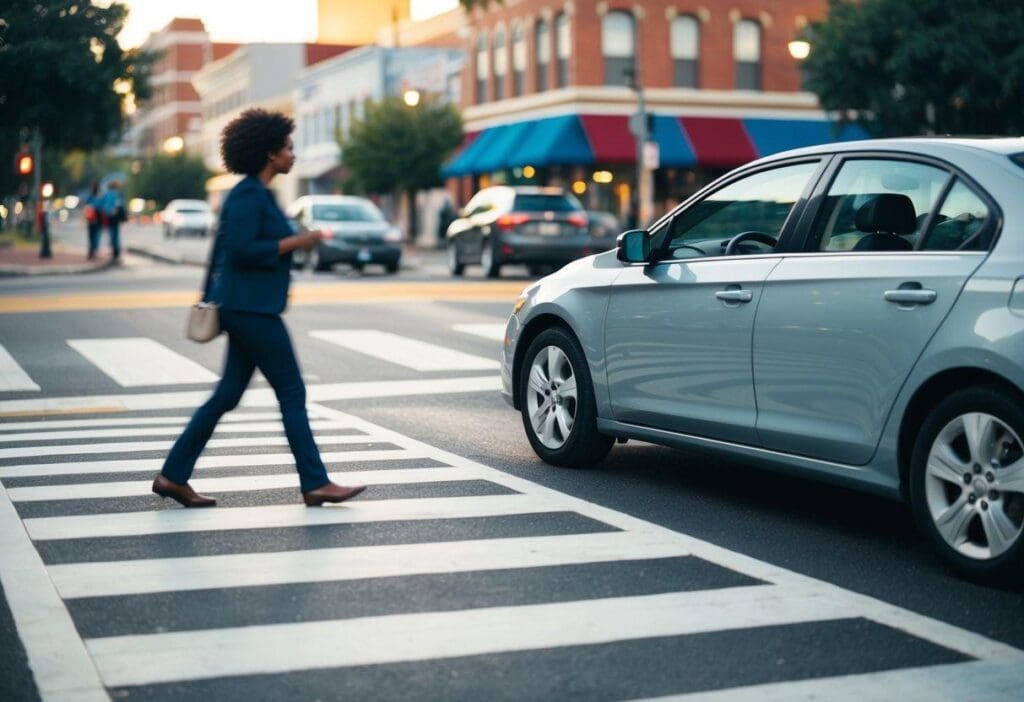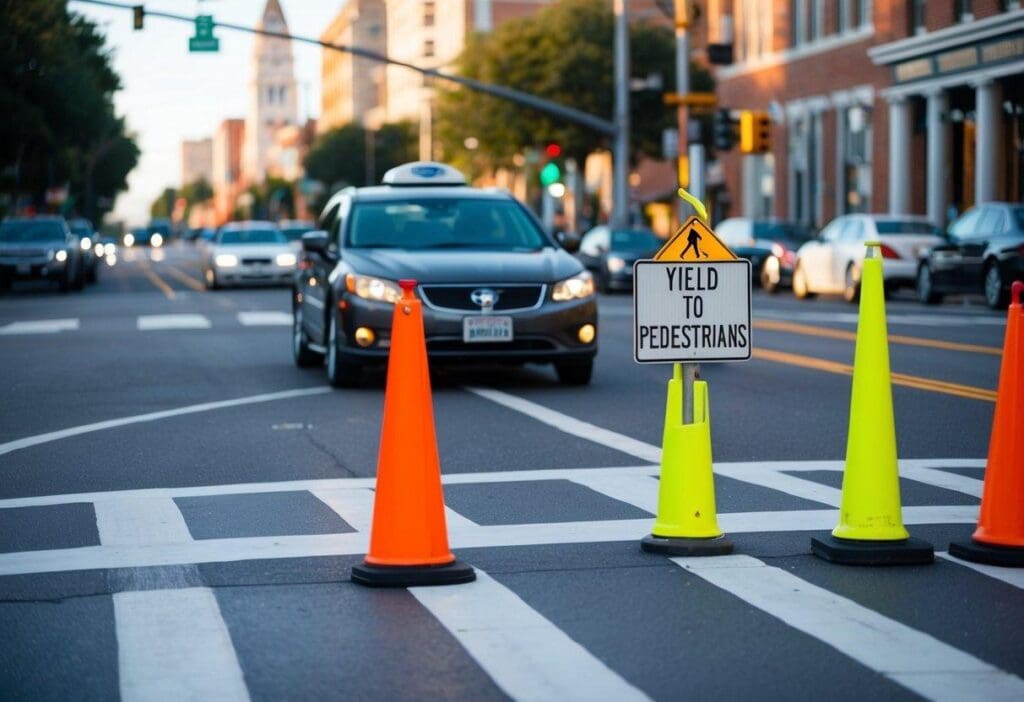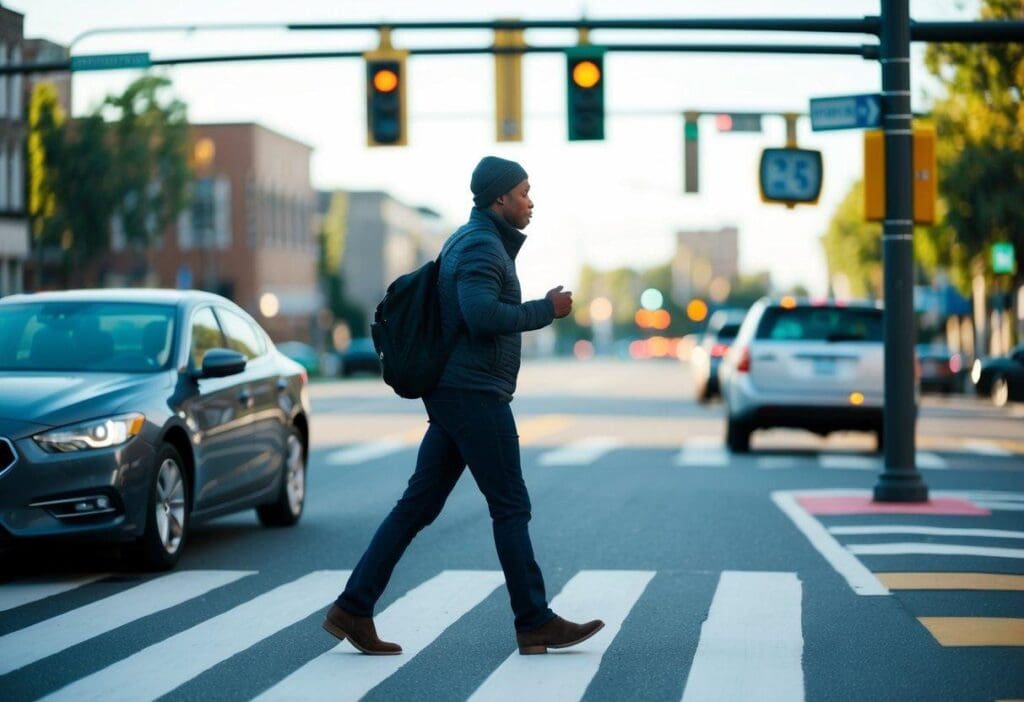Walking in St. George can be risky. In 2021, 846 pedestrians were in car crashes in Utah. I’ve seen many cases where people got hurt while crossing the street or walking on sidewalks and ending up needing a professional Utah personal injury attorney. Drivers who hit pedestrians are often liable for the injuries they cause.

When a car hits someone on foot, the results can be very bad. The person walking has no protection from the big, heavy vehicle. This often leads to major injuries or even death. If you’re hurt in a pedestrian accident, you may be able to get money for your medical bills and other costs.
Figuring out who’s at fault in these crashes can be tricky. Sometimes the driver is fully to blame. Other times, the pedestrian may have done something wrong too. That’s why it’s smart to talk to a lawyer who knows about these kinds of cases in St. George.
Key Takeaways
- Pedestrian accidents are common and often cause serious injuries
- Drivers are usually liable for hitting pedestrians, but fault can be shared
- Getting legal help is important for pedestrian accident claims in St. George
Understanding Liability in Pedestrian Accidents

Liability in pedestrian accidents can be complex. I’ll explain how fault is determined and what often causes these accidents.
Determining Fault in Pedestrian Accidents
When I look at pedestrian accident cases, I consider several factors to figure out who’s at fault. Driver behavior is key – things like speeding, distraction, or impairment can put the blame on the driver. But pedestrians aren’t always innocent. Jaywalking or darting into traffic can make them partly responsible.
Road conditions and signage matter too. Poor lighting or missing crosswalks can shift some blame to the city. Time of day affects visibility, which I take into account. In places like St. George, comparative negligence laws mean fault can be shared between parties.
Common Causes of Pedestrian Accidents
I’ve seen many reasons for pedestrian accidents in my work. Distracted driving is a big one – drivers on phones often don’t see people crossing. Alcohol and drugs impair judgment for both drivers and walkers.
Speeding is dangerous, especially in areas with foot traffic. Drivers who fail to yield at crosswalks cause many crashes. Poor visibility from bad weather or inadequate street lighting leads to accidents too.
In busy areas, pedestrians sometimes take risks by crossing outside crosswalks. This can catch drivers off guard. I always stress the importance of staying alert, whether you’re driving or walking.
Legal Process for Pedestrian Accident Claims
Filing a pedestrian accident claim in St. George involves gathering evidence, understanding Utah laws, and following proper legal steps. Time limits and specific procedures must be followed to seek compensation.
The Role of Evidence in Building a Case
I recommend collecting as much evidence as possible after a pedestrian accident. This includes photos of the scene, witness statements, and police reports. Medical records are key to show injuries. Traffic camera footage can be helpful if available.
I’ve seen how strong evidence can make or break a case. It’s best to gather proof quickly before it disappears. I advise keeping a journal of how injuries affect daily life. This can support claims for pain and suffering.
Expert witnesses like accident reconstructionists may be needed for complex cases. Their analysis can show how the accident happened and who was at fault.
Navigating Through Utah’s Personal Injury Laws
I know Utah’s personal injury laws can be tricky. The state has a 4-year statute of limitations for most pedestrian accident claims. This means you must file a lawsuit within 4 years of the accident date.
Utah follows a modified comparative negligence rule. You can still get compensation if you’re less than 50% at fault. But your award will be reduced by your fault percentage.
I’ve helped many clients deal with insurance companies. They often try to low-ball settlement offers. It’s important to know your rights and the true value of your claim before accepting any offer.
Compensation and Recovery of Damages
Getting compensation after a pedestrian accident can be complex. I’ll explain how to value your case, deal with insurance, and decide between settling or going to trial.
Evaluating Compensation for Injuries and Damages
I start by looking at all the costs from the accident. Medical bills are a big part. I add up hospital stays, surgeries, medications, and therapy. Lost wages matter too if you missed work. I also think about future expenses. You might need more treatment or be unable to work the same job.
Pain and suffering counts as well. It’s harder to put a number on, but very real. I look at how the injuries affected your daily life and activities. Severe or permanent injuries typically lead to higher compensation amounts.
Negotiating with Insurance Companies
Insurance companies often try to pay less than a claim is worth. I know their tactics. They may downplay injuries or blame the pedestrian. I gather strong evidence to counter their arguments. Medical records, expert opinions, and witness statements help build a solid case.
I handle talks with the insurance company. This protects you from saying something they could use against you. I push for a fair offer that covers all your damages. If they won’t negotiate in good faith, I’m ready to take the case to court.
Understanding Settlements and Trials
Most cases settle out of court. This can be faster and less stressful. I aim for a settlement that fully compensates you. We discuss any offers together. You decide if it’s enough or if we should keep fighting.
If we can’t settle, going to trial is an option. I prepare thoroughly to present your case to a jury. This takes longer but can result in a bigger payout. Trials have risks, but sometimes it’s the best way to get full compensation.
The choice between settling and going to trial depends on the details of your case. I give you my honest opinion on the pros and cons of each option.
The Importance of Legal Representation

After a pedestrian accident in St. George, getting legal help is crucial. A good lawyer can make a big difference in the outcome of your case. They know how to deal with insurance companies and prove who was at fault.
Selecting the Right Personal Injury Attorney
I recommend looking for a St. George personal injury attorney with experience in pedestrian accidents. Firms like Benzion and Martineau are good options to consider. When choosing a lawyer, I suggest asking about their track record with similar cases.
A skilled attorney will gather evidence, talk to witnesses, and work with experts to build a strong case. They can help you get fair compensation for medical bills, lost wages, and pain and suffering.
It’s important to meet with a few lawyers before deciding. Many offer free consultations, so you can ask questions and see if they’re a good fit. Look for someone who listens to you and explains things clearly.
The Contingency Fee Structure Explained
Most personal injury attorneys work on a contingency fee basis. This means you don’t pay them upfront. Instead, they get a percentage of your settlement or court award if you win your case.
The typical contingency fee is around 33% of the recovery amount. If you don’t win, you usually don’t owe the lawyer anything. This setup lets people get legal help even if they can’t afford to pay a lawyer right away.
Before hiring an attorney, I advise getting the fee agreement in writing. Make sure you understand what percentage they’ll take and any other costs you might have to pay. Some lawyers may charge extra for things like filing fees or expert witnesses.
